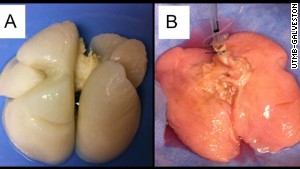Mr.Conley
Senior Member
Sept 11 responders suffer lung ailments
NEW YORK (Reuters) - About 70 percent of the rescue workers who picked through the toxic debris of the World Trade Center after the September 11 attacks suffered respiratory problems, a study released on Tuesday said.
ADVERTISEMENT
The Mount Sinai Medical Center study found police, firefighters and other responders had high rates of lung abnormalities for years after the attacks.
One-third continued to have abnormal lung function, many more than expected, when the study was concluded in 2004, and severe conditions including pneumonia were significantly more common in the six months after September 11 than six months before, said Robin Herbert, a professor at Mount Sinai School of Medicine.
About 70 percent of those who responded suffered new or worsened respiratory problems during or after their work and some 61 percent developed symptoms while working at the World Trade Center site, the study said.
"There is a strong correlation between World Trade Center work and respiratory illnesses," Herbert said.
The study is based on medical examinations conducted between 2002 and 2004 on close to 12,000 of the 40,000 September 11 responders, who breathed air tainted with the dust created when the Twin Towers were pulverized upon their collapse.
Mount Sinai, a private hospital, said its report is the largest multi-agency study to date of September 11 responders. Besides firefighters and police, responders included construction, utility and public sector workers.
Separately on Tuesday, New York Mayor Michael Bloomberg called on the federal government provide more funds to confront World Trade Center health issues and to reopen a compensation fund that stopped taking applications from victims in 2003, even though some discovered symptoms after that date.
"We're concerned looking down the road that the liability could be substantial," Bloomberg said. "No one city can possibly afford do it all on its own."
NEW YORK (Reuters) - About 70 percent of the rescue workers who picked through the toxic debris of the World Trade Center after the September 11 attacks suffered respiratory problems, a study released on Tuesday said.
ADVERTISEMENT
The Mount Sinai Medical Center study found police, firefighters and other responders had high rates of lung abnormalities for years after the attacks.
One-third continued to have abnormal lung function, many more than expected, when the study was concluded in 2004, and severe conditions including pneumonia were significantly more common in the six months after September 11 than six months before, said Robin Herbert, a professor at Mount Sinai School of Medicine.
About 70 percent of those who responded suffered new or worsened respiratory problems during or after their work and some 61 percent developed symptoms while working at the World Trade Center site, the study said.
"There is a strong correlation between World Trade Center work and respiratory illnesses," Herbert said.
The study is based on medical examinations conducted between 2002 and 2004 on close to 12,000 of the 40,000 September 11 responders, who breathed air tainted with the dust created when the Twin Towers were pulverized upon their collapse.
Mount Sinai, a private hospital, said its report is the largest multi-agency study to date of September 11 responders. Besides firefighters and police, responders included construction, utility and public sector workers.
Separately on Tuesday, New York Mayor Michael Bloomberg called on the federal government provide more funds to confront World Trade Center health issues and to reopen a compensation fund that stopped taking applications from victims in 2003, even though some discovered symptoms after that date.
"We're concerned looking down the road that the liability could be substantial," Bloomberg said. "No one city can possibly afford do it all on its own."

